Reshan and I presented at NAIS (National Association of Independent Schools) today. We shared our latest thinking on leading online. Though we plan to write about these ideas soon, for now you can follow the way our thinking is evolving by looking at today's slides.
A Conversation about Communication, Leadership, and Knowing What We Don’t KnowOn May 28, Leading Online talked with Curt Lieneck, Director of Information Technology at the University of Chicago Lab Schools. Though we had seen his name and read his words for many years as members of the Independent School Educators Listserv email distribution group, we only got to meet Curt in person when we were in Memphis for an educational technology conference. Reshan and Curt happened to sit next to one another on one of the shuttles from the hotel to the conference site, and later that day at another session Reshan heard Curt offer some very insightful words about the purpose of schools. We knew we wanted to keep learning from him, and we eventually asked him to contribute to our book.
Leading Online: In [the book] Leading Online, you use rowing as an analogy to explain the key to unlocking the magic of school. Can you explain the analogy again for our newsletter audience, elaborating on it if possible? Curt Lieneck: What struck me about the conversation I had with the rower was the combination of emotion and joy that he was able to share, in [regards to] everybody working in unison to achieve a shared goal, and the way that made him feel, despite the fact that it really hurts to row competitively at his level. Much of what we do [in IT] is stuff we've never done before, and if we have trust in each other and that level of confidence that we are going to work together, then it makes getting the boat rowing smoothly a lot easier than it would be otherwise. You can't have people who are daunted in any way by pain – and I'm using pain in two different senses here, of doing a lot of things you've never done before versus the physical pain of rowing. If you have people who are uncomfortable with being uncomfortable, it is painful to get things done. In that sense, the rowing metaphor has been a good one for me to keep in mind as we continue to tackle complicated things that we've never really done before, while at the same time delivering a reliable level of service and incident management and so forth as an IT team. Once you're in that situation where everybody is really working optimally together, it's something you don't forget, and you really want to experience that again and again and again. I don't know if it's the same sort of flow experience that Csikszentmihalyi was responsible for articulating, but it is nice to feel like you're on a different level than a lot of other people who go to work every day. LO: We love that you can pronounce the name Csikszentmihalyi. CP: I think you can't pick up your University of Chicago paycheck unless you learn how. LO: Good point. Do you feel that you can create that sense of rowing together using online tools? The things that you are talking about. . . do those have to happen in person? CL: It's not often physically possible to get a lot of people in the same place at the same time, but, certainly as a consultant, I've had the experience of working on very difficult projects with people I've never met before who weren't anywhere in physical space where I could get in touch with them. And whether it's through the phone, or by sharing documents and so forth, the people who are good at expressing themselves and being able to put their expertise forward in a non-threatening kind of way . . . yeah, we've had that experience of really solid teamwork on a small consulting group of five or six folks. Whether that scales to large numbers of people, I’m not sure. I do know that some of the same principles apply – that you have to be open, you have to be vulnerable, and operations have to be transparent to the extent that you can engender trust. Those are all necessary conditions for the sort of teamwork experiences that I [am describing]. I play online pool and it's interesting because the app picks a random person for you to play against. You can tell by the way people play and the comments that they make that some of them are really nice people. You end up playing a lot longer with the nice people than you normally would otherwise. (I do wonder sometimes if our [students] are developing a sixth sense about such things because they've been more inured to the online environment than certainly I was growing up.) But I guess to the extent that people can be authentic online and have something to contribute online, yeah, I would say those experiences can happen [on or offline]. I know they've certainly happened on those consulting engagements I've been on. Then when you actually get to meet these people in person, it's just hilarious because they really are who they are online, and that fit is just fabulous. LO: We've been studying Nick Morgan’s work, about when you communicate face-to-face. In order to be authentic in your communication, you have to believe in your message and then also communicate it in a way that people believe that you believe it. Do you think there is a parallel process in the online world where you meet people online and you have a gut reaction that this person is authentic or this person is inauthentic or this person is really nice? CL: [A question I would ask is,] “does somebody need to be the smartest person in the room?” Even online, you can tell those people a mile away. In my world, if you need to be the smartest person in the room, you aren't. I also think people who are good at expressing themselves come across online as they would in person. LO: This conversation is making me think about email etiquette. I know I can think of some examples where some of the simple graces, or the absence of them, in an email, especially from a leader to a large group, can change how a message is received. Without naming anybody, or throwing anyone under the bus, can you think of a time where you've been on the receiving end of bad email communication? And also, on the flip side, what do you do with intent when you communicate via email to the people you lead or the community you serve? CL: The most outstanding example was when I was at the wrong end. I learned at one time that a reporting relationship I had enjoyed for close to 10 years had been changed, and I was informed about that [change] in an email as part of a diagram of a new org chart. [This message came] without any kind of in-person preparation at all. For somebody as heavily invested in building strong working relationships as I am, I was so disappointed. It was a real head scratcher. It was like, “Really? Is this the way we're going to do business? I hope not.” It turned out to be the exception rather than the rule from the people involved, but it did happen in a number of other areas of school life involving an administrative team that, I felt, needed some schooling in how to [communicate] properly. Another path, though less efficient, would have been the more effective way. In my own work, I'm very careful, first of all, to keep things brief. So if there are really heavy nuances in [a message], then email is just not the right medium. I feel like I'm Captain Obvious here. There's the old saying that content is king, and I don't actually believe that; I think context is king. Whatever message I have, I always take a sentence or two to try to put it in some kind of context by saying, “You may recall that this effort was taking place and one of the things that was being investigated was X.” The second paragraph is, “Okay, we've made some decisions about that” – that's the second two-line paragraph. A third two-line paragraph is, “If you want the more detailed explanation on the technical side of this, for those of you who are geekily inclined, then I put the long explanation under my signature and you can go look at that at your leisure, or not.” Then, always at the end, “If you have questions or concerns, feel free to email or stop by my office, etcetera.” I think I've gotten pretty good at those kinds of emails over the years. When I first got into IT after coming out of the classroom for many years, I had a very bright young man who got stuck with helping me understand technology in ways that I hadn't before. Back then, when I would start writing emails about technology, he would just throw them back at me and say, “What's the fourth grade version?” He said, “You're the best fourth grade teacher I've ever seen. . . . What message would you send to the fourth grade?” And that's been really, really helpful because I'm always looking to prune, to undo, and to keep things as rock-solid clear as possible. I think leaders need to understand when email's the right medium for getting something done; then, [if they choose to use it,] they always need to provide the context that goes along with the content of the information. Sometimes in our hurry to get stuff done, we forget about that context part. LO: Are there other things in your past – like the exchange with the colleague who would throw an e-mail back at you – that prepared you to lead well either online or offline? CL: For a good part of high school and a little bit of college, I got by just by being charming and funny – until I had to start writing a lot of papers. I never had to write a lot of papers in high school. But when I ran into a humanities teacher during my sophomore year at college, he pulled me aside and said, “You're way smarter than this paper tells me. You don't really know how to write these do you?” And I said, “No, I actually don't.” And so he said, “Curt, you're going to come to my office two days a week for the next three months, and by the time you get out, you're going to know how to write.” And it was a really good lesson for me – that being charming and funny is great, but you also have to produce if you want to earn respect. I've hired a number a of people who are very funny and charming and delightful to be around, but I’ve learned that we have to be focused on results in addition to enjoying the work that we do. In terms of leadership, too, I think you can't be afraid to say that you don't know the answer to something. You have to model that for people and, boy, on my first few years on this job – and still to this day – there's a lot that I just don't know about technology. For example, once a month all of the tech leaders from the different sub-units get together [at the University of Chicago]. And if there's something that I don't understand, I'll just raise a hand and say, “I know most of you all know exactly about all of this, but I don't. Somebody give me a two-minute explanation about this thing that you're talking about and why it's important to know.” For my own staff, I think that's been a very helpful [move] because they don't feel like they have to have all the answers. The woman who ran the graduate school program that I went to was always diligent about being very, very clear about what was expected from you. [At work, too,] if your staff is not clear about what's expected of them, you're going to be unsatisfied with anything they do. My people know exactly what I expect from them and they also have told me what they expect from me. At the end of any meeting, [in fact,] I will always ask, “Is there something I need to be doing that I am not?” And I don't want to embarrass people either at meetings, but if there's a need to go back one-on-one and say, “Maybe we're not clear on this, but I'm expecting that you're going to do this in this situation, and if I didn't make that clear, that's on me.” LO: All right, so this will be our closing question. Dream big. What do you think school or schools will look like in 10 years? CL: Well, I guess I would ask, which schools? The cynical part of me wants to say that a lot of independent schools will look kind of like they look right now, only maybe fancier and better. They've got a good thing going and they know it. Public schools, I have no idea. I just have no idea. I have a feeling if I did have an idea, I could earn a lot of money telling people what it would be. But, I do think that some of us – some aspect of what we do – will become less and less relevant unless we can really focus on that value proposition of, “We do things here that you can't do any place else.” If an old guy like me can learn to play punk rock without ever having an in-person guitar teacher, just by going on Coursera, you know that things are different. Though I’m not the biggest Dan Pink fan, I think he was right when he said that, more and more, the world is going to reward those people who do things only they can do. Steve and Reshan enjoyed their time in Boston this week attending sessions and presenting at the ERB 2014 conference in Boston, MA. Below are the slides from their presentation and here is a link to the collaborative notes taken by participants in the session. We'll be guest moderating that #1to1techat on Twitter on Wednesday, June 4th at 9 PM ET (8 PM CT). Our topic is "Leading Online: Asking for and Accepting Help."
As we have been doing with previous workshops and presentations, we will (attempt to) take the participatory experience and weave it into a narrative that will become part of our ongoing follow up project - Leading Online: A Networked Version. Please join us! When I was at SXSW several weeks ago, I was in the "Google" lounge waiting to chat with some people about Explain Everything and I happened to see Getting Smart's Tom Vander Ark sitting and chatting with some people nearby. I went over to introduce myself. Though we had exchanged DMs around the time that Leading Online was released, I did not expect him to remember me. Still, I felt that it was important to say hello to someone with whom I had engaged online. We spoke very briefly and before he left he gave me a card and suggested that I do a guest post on the Getting Smart blog. Several weeks later, Steve and I finished an article based on our chapter about meetings and the GettingSmart team reviewed, approved, and posted the article. There is some serendipity around how this article transpired. Sure, we could have followed Getting Smart's guidelines for guest submissions on our own. But the combination of a Twitter exchange and a chance face-to-face meeting allowed something to be created from nothing. It just took some follow-through. The next time someone hands you a card, follow up with them. You never know to what end (or beginning) it might lead! — RR
IF you have an iPad program or your colleagues have iPads... AND IF you are looking for an innovative summer read for yourself, your faculty, your trustees, and/or the leaders of your school... AND IF you seek to disrupt the traditional way that summer reading (and subsequent debriefing) are done... THEN please keep reading! While our book, Leading Online, has received a warm welcome from bestselling thought leaders like Dan Pink, Adam Grant, and Dr. Nick Morgan, we wrote it for you — educators and school leaders — so that you would read it and discuss it with others like you. Leading Online is a book for leadership teams, for full faculties, for business offices, and for collaborative teachers. Leading Online models what is possible with emerging interactive technologies by engaging readers in a unique learning experience as they read. Some people have read it and learned about leadership. Some people have read it and learned how to do more with their iPads. Some people have connected with its "drop-in" authors (10 total) to widen their networks. Some people have looked at the book's sketchnotes and started to develop a visual vocabulary to complement their written language. Some people have inquired about ways to use the iBooks platform to publish their own work or the work of their students. As bestselling author Adam Grant said in one of the book's more generous and potent blurbs, "It's more than a book: it's a demonstration of how the internet and social media can change the way we lead and learn." 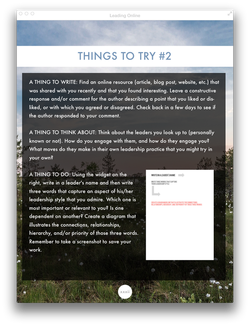 With sketchnotes by Brad Ovenell Carter, and contributions from innovative leaders like Scott McLeod, Kristen Swanson, and Scott Rocco, the book aims to do what it says. Chapters concludes with “Things to Try” that can be completed as individuals or in groups — depending on how you want to structure the ongoing and follow-up conversations around the text and experiences. We have reduced the price by half (now only $4.99 USD) after hearing from many schools who wanted to do a bulk purchase of the book for their faculties in the same way that they purchase iPad apps via apple’s Volume Purchase Program (VPP). We’ll keep the reduced price in effect until June 30th, 2014. Here is where you can buy a single copy of the book: https://itunes.apple.com/us/book/leading-online/id791774966?mt=11 Here is where you can buy multiple copies via Apple’s VPP: http://volume.itunes.apple.com/us/book/leading-online/id791774966?mt=11&term=leading%20online&ign-mpt=uo%3D4 And Steve and I are happy to help you buy multiple copies even if you are not part of Apple’s VPP. Regardless, have a great END (IF in the northern hemisphere) of the school year! -Reshan & Steve Reshan and I think learning is so important for leadership that we used the word in the subtitle of our new book -- twice! Leading the learning, learning by leading: if you pull on one end of that grammatical construction, you ultimately end up on the other end. Now that the book is published and starting to find its audience, we have shifted some of our energy to helping leaders and leadership teams acquire tools to (a) learn effectively and (b) apply that new learning to new leadership situations. Showing a leader how to use Evernote is an example of giving her a new tool. Mentoring that leader as she uses Evernote to share documents and notes with a committee that is having trouble meeting face-to-face is an example of helping her apply new learning to a new leadership situation. Inviting a leader into a one-on-one Google hangout is an example of giving him a new tool. Helping him to use a Google hangout to join two groups, from two schools facing a similar problem, is an example of helping him to apply new learning to a new leadership situation. One of my favorite new tools is one we used in our book. If you've flipped through it, you know that we have embedded a widget -- called "engage with us" -- at the end of every chapter. This tool allows readers to tell us what they think after reading a chapter, and we do our best to respond as quickly as possible. For me, the widget is a new tool (a new category of tools, really), and it's helping me to learn in a way in which I previously could not. The situation in which I've been learning is one that, I'd imagine, is common to most readers -- it's the situation in which you are so busy that you can't even think about learning. I have been particularly swamped at work and home lately, so I have not been actively trying to learn -- I haven't been paying attention to my twitter stream or consuming media or new books. I haven't been engaging in deep conversations. But this widget, which Reshan set up months ago, keeps churning. It keeps pulling in interesting voices and thinkers. It keeps surprising and delighting me, even when I don't have the time to be surprised or delight. In short, it keeps my learning mechanism engaged, even when I swear I can't -- or won't -- learn due to excessive demands. Here's an example: Ted Parker (@MrTedP) recently responded to our book using the aforementioned widget. As I said, I have been busy, but Reshan had a slice of time one evening and he used it to engage in some dialogue with Ted. I didn't have time to participate in the conversation, but since I am wired into it through the widget, it eventually crossed my screen. As I read it, I realized I was in a very lucky spot -- I was an observer of two passionate practitioners who were talking shop in my digital backyard. All I had to do was pull up a chair and listen. At one point, Ted said: This is my first iBook, and I think the "engage with us" idea is great! I've found myself using it as more of a deliberate prompt to reflect at the end of the chapter -- perhaps a secondary use to the primary intention of raising questions and prompting back-and-forth discussion. There's great value to both uses! This response reminded me about the difference between intention and reception. Reshan and I intended for the widget to be a way for readers to engage with the book and its authors; Ted made us realize that the widget also promotes a reflective activity. When intention and reception don't match, conflict can emerge; at the same time, as the case above illustrates, learning can occur. Reshan and I have vowed to "mind the gap" between our book's intentions and our book's reception, and to use such knowledge to inform future editions of the book and future projects associated with it. (We were inspired in this regard, too, by a recent blog post by Austin Kleon that mentioned Brad Ovenell-Carter, a.k.a. @braddo, a.k.a. the force of nature who created such beautiful and useful illustrations for Leading Online.) At another point, Ted and Reshan found some common ground. Both are leaders and both are technology integrators, and it was fascinating to hear their commitment to what's happening inside the hearts and minds of the teachers with whom they work. Here's Ted again: I completely share your emphasis on learning as the essence of online leadership. We ourselves must learn constantly and must as well spur constant learning among those whom we lead. It seems to me the cultivation of a growth mindset in oneself and others could be the most important leadership skill of all. And here's Reshan: We're so glad that you connected with this point. I recently completed a big research project on educational technology -- but the focus was not at all on the technology but on the beliefs and practices (i.e. mindsets) of the teachers involved. I do think there is a parallel when considering online leadership -- or leadership in general. One's ability to learn and grow is directly connected to one's ability to lead others through their own learning and growth. Next, the two break off into a discussion of User Experience (UX), an under-discussed topic in our schools. Again, you can see the cross-pollination of ideas. I really appreciate the [book's] points about UX. As an EdTech integrator, I have sometimes worried about how much time I spend using tech to create efficiencies for teachers rather than helping them to see tech's truly transformational power. That's obviously a worthwhile concern to have -- we should spread out our work along the SAMR spectrum -- but efficiencies also create the space for teachers to explore their own innovations. (Ted) And finally: I'm thinking that, hopefully, introducing a team to online meetings and reflecting critically with the team about such meetings' benefits and drawbacks could be a great way of building digital literacy and encouraging team members to seek further online professional interactions. (Ted) I really, really didn't have time to learn this week. But I did anyway thanks to Ted Parker, Reshan Richards, and a faithful widget.
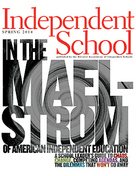 Steve's recent article is on the cover of the Spring 2014 issue of Independent School Magazine. The full title is In the Maelstrom of American Independent Education: A School Leader's Guide to Chaos, Change, Competing Agendas, and the Dilemmas that Won't Go Away. You can read the article on the NAIS website by clicking the linked title. I like when people share a slide deck, and I like it even more when people provide some context to go along with it. So that is what I am attempting. I recently returned from SXSWedu in Austin, TX. Below are the slides from my presentation which was titled "Grades are Stupid: Let's Talk About Assessment!" For each slide, I've added a caption at the bottom of the slide that briefly describes what I intended to talk about at that moment. I think it might be difficult to guess otherwise. [RESHAN] Klingbrief is a publication that I read and liked before I actually joined the editorial board. I’m actually not sure how or when I heard of it . . . probably through an email from the Klingenstein alumni list (I attended the Klingenstein Summer Institute over a decade ago, and I’m glad that the center has kept track of me). But I do remember thinking, when I first started reading it, that the idea was both natural and obvious, in the best possible ways. It seemed natural that such a publication would originate at the Klingenstein Center, a place that, for many, is the nerve center of independent school education. Of course a project like Klingbrief, one that hopes to organize and articulate the trends wafting through the independent school community, would gain its footing in the place where so many of us gain our professional footing. It seemed obvious in that it mimics a natural function of the professional communities within and among independent schools. Recommended readings and viewings fly around daily in our schools. Klingbrief seeks to capture the best of those readings and viewings and hopefully dig up some new ones. So, it’s a collection both of what people are paying attention to and what people should be paying attention to. It’s both soothing – i.e., here’s what people are talking about – and provocative – i.e., if you’re not paying attention to this, you should. I'm writing about Klingbrief here, on a blog devoted to leading online, because I think the enterprise is a great model for other groups looking to make similar contributions in similar spaces and ways. Here's how Klingbrief works: Each month, a call for submissions goes out to subscribers, and each month, shortly after that, submissions pour into the Klingbrief inbox (the email address is [email protected] if you're interest in submitting). Those submissions are whittled down by the coordinating editor, who then distributes, again via email, a first draft to the other editors. The editors debate the merits of each submission, ultimately selecting approximately ten submissions for publication. The publication goes live toward the end of each month. What's remarkable about the publication is that the editors are only in the same room once a year -- when they meet at the National Association of Independent Schools' conference. We come from schools across the country: And yet, we have developed a rich, collaborative community of practice with the simplest of tools -- email, a website, and the occasional conference call. We have conversed with and influenced one another, argued and synthesized, analyzed and made decisions -- all online. And, all online, we reach almost 5000 subscribers and countless others through the Klingenstein website and the Klingbrief Twitter page (@klingbriefer). We reach, and so inform, all Klingenstein alumni, all NAIS heads, other interested independent school administrators and teachers, and many other individuals. Here's why I think Klingbrief is a noteworthy example of online leadership: (1) The agendas of independent schools are too important to be left only in the hands of those people who hold top administrative positions. Likewise, the teachers in our schools, the ones who have direct contact with our most precious resource – the students – are often too busy to read widely during the school year. Klingbrief serves administrators and teachers alike, and by extension, schools and students. For example, in one 2013 issue, Chris Lauricella paired, in a single submission, Battle Hymn of the Tiger Mother and Race to Nowhere. In his words, these works “represent two visions of how we do or do not respond to the pressures placed on higher achieving youth in America. These two works, arousing controversy as they make the rounds, offer us a litmus test of our complex feeling about achievement in 21st century America.” By showing both sides of the debate, Mr. Lauricella framed the discussion in a responsible manner, helping leadership teams at schools do the same. (2) The peer review aspect of Klingbrief ensures quality. If your submission is accepted, you know it has been compared to other submissions; you know it will be in good company; you know it will become part of the Klingbrief legacy. A few words on this legacy, which is already apparent after only 20+ issues: Klingbrief is filled with evergreen articles, making it a treasure trove for leadership teams or administrators looking to pursue a certain discussion. In it, you can find thematic strands ranging from the way technology is affecting our brains to the way privilege functions in our schools. Looking further into the future, it becomes possible to see the Klingbrief project in another light as well. No doubt it will serve as a historical record of the kinds of issues that occupied the minds and lives of independent school educators – the items they battled against, the subjects that stoked their passions, the insights that helped them advance their particular form of schooling in a fierce and deliberate manner. (3) Finally, and perhaps most important, I think that anyone working in an independent school has a responsibility to hold, and express, an opinion about what independent schools should mean. Should we flip our classrooms? Should we allow social media in our schools? In what kind of professional development should we invest? What tensions should we embrace in order to avoid becoming provincial in our thinking? The Klingbrief stream is rich and varied, passionate and diverse, authentic and challenging, like our schools on their best days. It would not be possible without the passions of its contributors -- and the simple online tools that allow those passions to be shared, shaped, channelled, and distributed. ~Steve ~~~ The Klingbrief editors are presenting at the NAIS conference in Orlando on Thursday, February 27, from 1:30 - 2:30. Our presentation description and slides are below: |

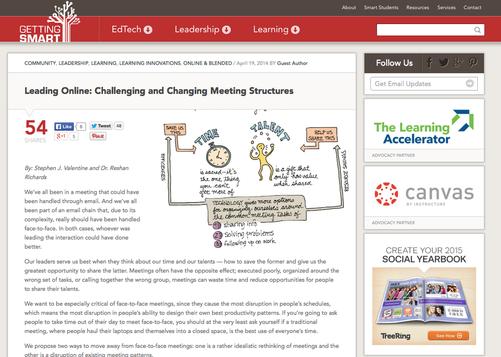
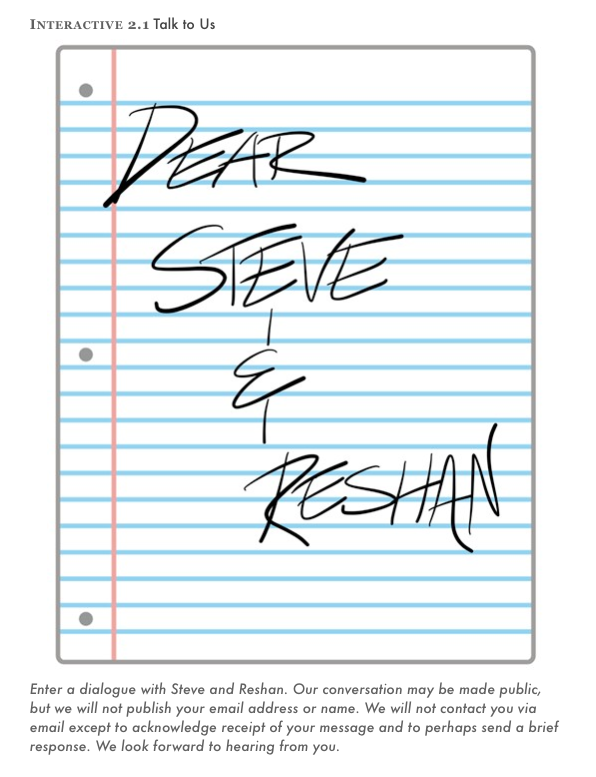
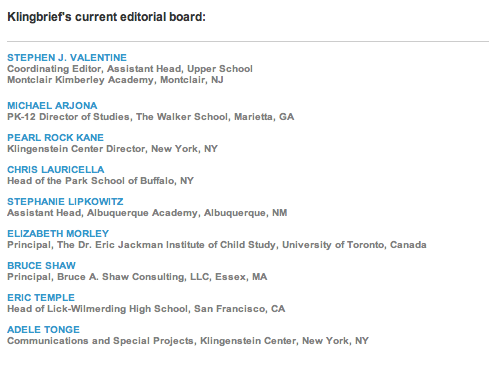
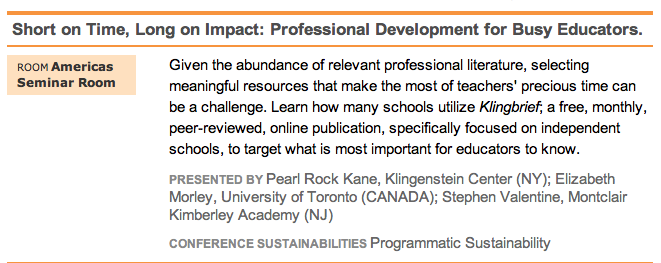
 RSS Feed
RSS Feed
